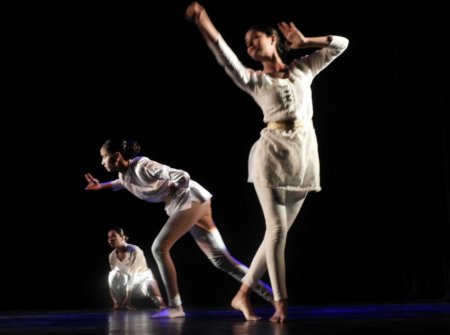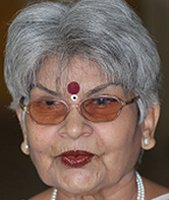
|   |

|   |
Purush and Prakriti: An unusual dance production - Manjari Sinha e-mail: manjari@sinha.com Photos: Emeli Munshi Chanda December 12, 2022 'Purush and Prakriti', a commendable production presented by Akriti Kathak Kendra, Hyderabad, premiered at the Sri Ram Centre, Delhi, recently. Directed by Nisha Mahajan, the senior Kathak exponent, teacher, choreographer and Yoga practitioner who has connected Kathak to Yoga for a balanced and wholistic approach not just to dance but to life itself, 'Purush and Prakriti' deals with the conflicts that we face in our day to day life and offers a legitimate solution. Conceived by Late Pandit Shambhunath, the dance work focuses on the role of an important aspect of our ancient culture, the Ashtanga Yoga of Maharishi Patanjali, in equipping the individual to deal with turbulence and strife to reach the state of harmony at the physical and mental, emotional and spiritual levels. Committed to preserving, promoting and facilitating Kathak across the globe, Akriti Kathak Kendra is like a sanctuary where the students find inner strength, values, discipline and joy through dance along with the physical aspect of learning Kathak. And this internalizing of the philosophy behind the art form leads them to imbibe values that last for a lifetime. The idea of Purush and Prakriti matched their ideology and Nisha was the most competent person to direct the production with full conviction. With a capable team of senior and upcoming dancers and Yoga-Saadhika, Nisha successfully transcreated the concept of Pt. Shambhunath introduced to her decades ago during her early stages of training at the Kathak Kendra, New Delhi.  The curtain opened to the primordial sound of 'Aum' and the Sanskrit shloka "Purnamidam Purnamadah... Purnameva avashishyate" with a portrait of a Yogi in the background and the ambience of piety echoing through the serene swaras of raag Vibhas on flute. The unusual opening traced the course of evolution from amoeba, reptiles, birds, mammals (deer, elephant and monkey etc) to man. This process of evolution was portrayed through an imaginative choreography performed by the younger lot of students quite effectively. The established practitioners of Kathak like Nisha Mahajan herself, Mangala Bhatt, the founder director of Akriti Kathak Kendra (Hyderabad), Abhay Shankar Mishra, Puja Mani, Hemant Kalita and Jyotsna Banerjee took the stage thereafter. Emerging from Purusha, the cosmic self, it was the emergence of a man endowed with Rajas, Tamas and Sattva Gunas. In the absence of Sattva, a man leads a life of conflict and emotional distress. He is besieged by negative tendencies like Kaam (lust), Krodh (anger), Lobh (greed), Moha (attachment) etc, the six enemies of our mind that the Indian philosophy teaches us to overcome. This production emphasized that through Yoga, man can find a way to peace, harmony and fulfilment. Opening with an Aalap in raag Bageshri, the Rajas was shown as the source of creative ability evolving through Kathak by the dancers on a bandish in the same raag set to teentaal. The raag changed to Chandrakauns for Tamas resulting in the lethargy and the sluggish inebriated state of the dancers with no control over their bodies. This is naturally a hindrance to the creative ability which is naturally bestowed upon human beings. This state of Tamas was effectively created by the aalap and a Gat composition in Chandrakauns, set to slow tempo on teentaal, on the somber sound of sarod. The Sattva Guna is activated when the mind takes charge of the chariot of the body to reach it to the destination of contentment and equilibrium. It is the absence of Sattva that causes lust, anger, greed, attachment, Madh (pride) and Matsarya (jealousy). Yoga is the only way out of these negative tendencies because it is defined as "Yogah Chittavritti Nirodhah" in the Yoga-Sutra of sage Patanjali. And the proper way is shown through the eight limbs or steps of the Ashtanga Yoga, which are Yama (restraints, moral discipline or vows), Niyama (observances of positive duties), Asana (Yoga postures), Pranayama (breath control technique), Pratyahara (sense of withdrawal), Dharana (concentration), Dhyana (meditation) and Samadhi (absorption).  To depict all these, a Yoga Sadhika was shown on a higher platform practising Pranayama and various Yoga asanas, while the other dancers followed it along with the Kathak repertoire from slow to the medium and fast tempo of teentaal dancing the Uthaan, Thaat, Aamad, Tode-Tukde, Paran, Tihais, Gat-Nikas to Tatkar reaching the climax where Nisha comes in and leads all the dancers to the ultimate bliss of merging into the Param Atma like the flight of a free bird. Thus the production 'Purush and Prakriti' underscores the message that Yoga can relieve society of the insensibility, chaos, and violence that tragically sweep through it today! The concept of Pt Shambhunath with music by Late Anupam Mudgal was a long-awaited presentation which finally could take its final shape with the script and direction by Nisha Mahajan and could be premiered long last. Special thanks were offered to R.R. Joshi, Kamalini Dutt, Rekha Bharadwaj and Vishal Bharadwaj for their support. The positive message of the inspiring production came through quite convincingly despite the scope for improvement, which is always there for any creative endeavour.  Manjari Sinha has an M.A. in Sanskrit and Music, and trained in vocal, tabla, sitar and Kathak dance. She has regular columns in national dailies as a music and dance critic. |